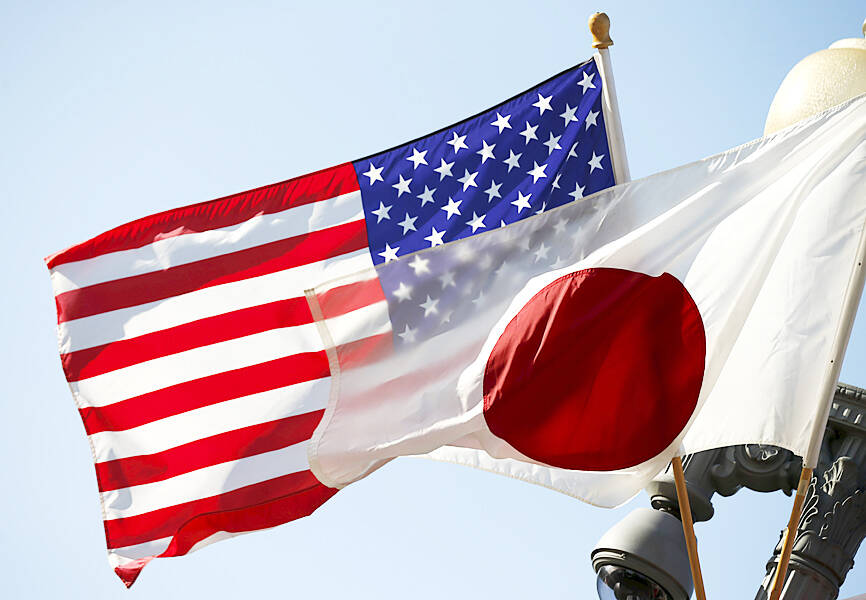The US is contemplating plans to strengthen the functions of the US Forces Japan Headquarters to promote cooperation between the US military and the Japan Self-Defense Forces due to concerns about a potential Taiwan contingency, the Yomiuri Shimbun reported yesterday.
The US government has begun to plan the adjustment to promote interoperability between the militaries of the US and Japan, the newspaper cited multiple Japanese and US government officials as saying.
The changes are to be made in coordination with Japan’s plan to establish a joint headquarters to command its ground, maritime and air forces by the end of March next year, it said.

Photo: Reuters
Japanese Prime Minister Fumio Kishida is scheduled to meet with US President Joe Biden on April 10 for a summit in the US, it said, adding that a joint statement to be issued after the summit might include the plan to adjust the US Forces Japan Headquarters.
“We are in discussion about how our planned joint command can strengthen cooperation with the US and South Korea,” Japanese Chief Cabinet Secretary Yoshimasa Hayashi said yesterday at a regular news conference when asked about the reports.
The agenda for the Biden-Kishida summit has not yet been decided, he added.
The headquarters currently has limited authority regarding the supervision of Japan-US joint exercises and the implementation of the US-Japan Status of Forces Agreement, the Yomiuri Shimbun said.
The US Indo-Pacific Commander, headquartered in Hawaii, has command over the US Navy’s 7th Fleet based in Japan’s Yokosuka and US Marine units based in Okinawa Prefecture, it said.
As China is stepping up its military coercion in East Asia and there are concerns about the possibility of a Taiwan contingency, some are worried that it would be difficult to make timely responses under the current system, which requires coordination between Tokyo and Hawaii due to the time difference, it said.
The adjustment under discussion aims to expand the authority of the US Forces Japan Headquarters without taking away the command authority of the US Indo-Pacific Commander, it said.
There is a proposal to give the Tokyo headquarters authority to plan joint Japan-US exercises and training, as well as to work with the joint headquarters that is to be launched next year on coordination, information sharing and distribution of materials, it said.
Another possible arrangement is to establish a permanent joint team in Japan to ensure closer coordination between the Japan Self-Defense Forces and US forces in Japan, it said.
Unlike in Japan, US troops based in South Korea and the South’s military are under a single command authority, it added.
Additional reporting by Reuters

STILL COMMITTED: The US opposes any forced change to the ‘status quo’ in the Strait, but also does not seek conflict, US Secretary of State Marco Rubio said US President Donald Trump’s administration released US$5.3 billion in previously frozen foreign aid, including US$870 million in security exemptions for programs in Taiwan, a list of exemptions reviewed by Reuters showed. Trump ordered a 90-day pause on foreign aid shortly after taking office on Jan. 20, halting funding for everything from programs that fight starvation and deadly diseases to providing shelters for millions of displaced people across the globe. US Secretary of State Marco Rubio, who has said that all foreign assistance must align with Trump’s “America First” priorities, issued waivers late last month on military aid to Israel and Egypt, the

France’s nuclear-powered aircraft carrier and accompanying warships were in the Philippines yesterday after holding combat drills with Philippine forces in the disputed South China Sea in a show of firepower that would likely antagonize China. The Charles de Gaulle on Friday docked at Subic Bay, a former US naval base northwest of Manila, for a break after more than two months of deployment in the Indo-Pacific region. The French carrier engaged with security allies for contingency readiness and to promote regional security, including with Philippine forces, navy ships and fighter jets. They held anti-submarine warfare drills and aerial combat training on Friday in

COMBAT READINESS: The military is reviewing weaponry, personnel resources, and mobilization and recovery forces to adjust defense strategies, the defense minister said The military has released a photograph of Minister of National Defense Wellington Koo (顧立雄) appearing to sit beside a US general during the annual Han Kuang military exercises on Friday last week in a historic first. In the photo, Koo, who was presiding over the drills with high-level officers, appears to be sitting next to US Marine Corps Major General Jay Bargeron, the director of strategic planning and policy of the US Indo-Pacific Command, although only Bargeron’s name tag is visible in the seat as “J5 Maj General.” It is the first time the military has released a photo of an active

CHANGE OF MIND: The Chinese crew at first showed a willingness to cooperate, but later regretted that when the ship arrived at the port and refused to enter Togolese Republic-registered Chinese freighter Hong Tai (宏泰號) and its crew have been detained on suspicion of deliberately damaging a submarine cable connecting Taiwan proper and Penghu County, the Coast Guard Administration said in a statement yesterday. The case would be subject to a “national security-level investigation” by the Tainan District Prosecutors’ Office, it added. The administration said that it had been monitoring the ship since 7:10pm on Saturday when it appeared to be loitering in waters about 6 nautical miles (11km) northwest of Tainan’s Chiang Chun Fishing Port, adding that the ship’s location was about 0.5 nautical miles north of the No.